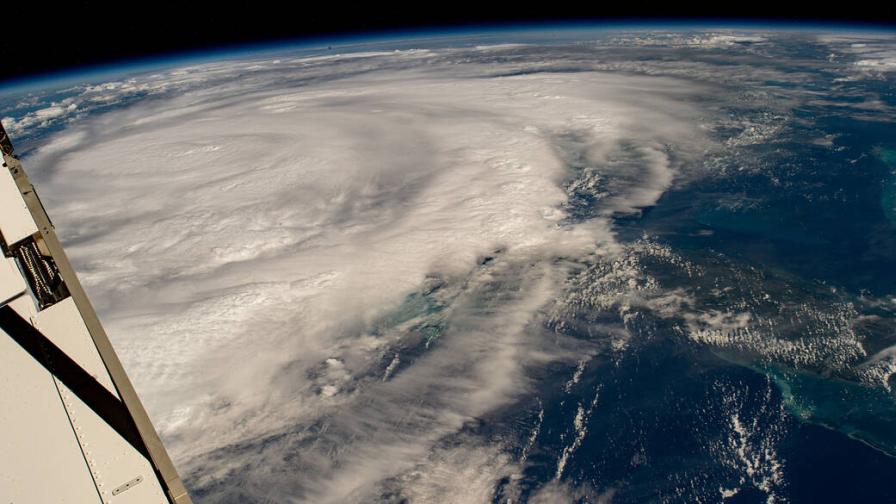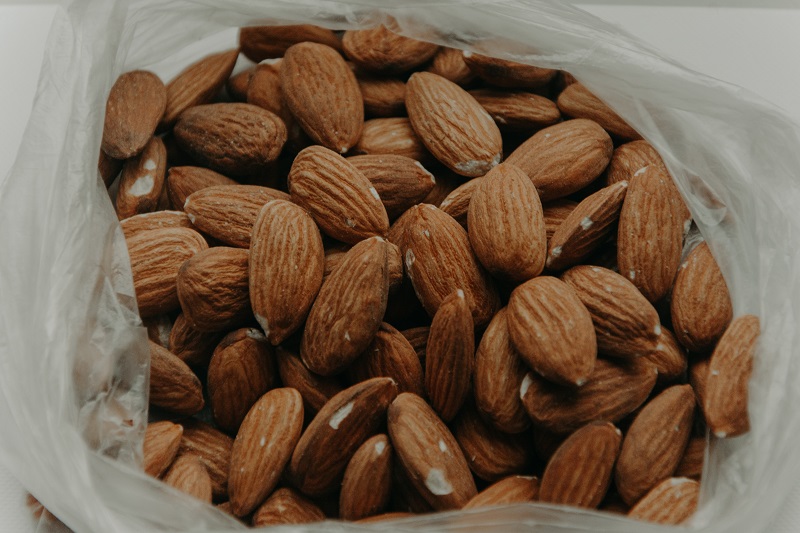Southeast Georgia Growers Share Details in Aftermath of Hurricane Idalia

As the International Space Station orbited above Earth on Aug. 29, 2023, one of the space station’s external high-definition cameras captured Hurricane Idalia in the Gulf of Mexico. The major storm would make landfall in Northwest Florida and race across Southeast Georgia, causing extensive damage to farm operations in the path.
Image courtesy of NASA
Hurricane Idalia had a sweet name but left bitter bruises on Georgia farms and rural communities after sweeping across the Southeast part of the state on Aug. 30. Idalia made landfall as a major Category 3 storm in Florida’s Big Bend and was a Category 2 storm (sustained winds of 96-110 mph) when the eye blew across the Florida/Georgia line into Lowndes County about 10 a.m.
Initial assessment reports released by the Georgia Department of Agriculture (GDA) and UGA Extension detailed major agriculture damage in Brooks, Ben Hill, Berrien, Coffee, Cook, Crisp, Echols, Irwin, Lanier, Lowndes, Pierce, Thomas, and Wilcox counties.
Idalia uprooted pecan trees, blew over corn and cotton stalks, battered vegetable plants, and tossed tobacco leaves to the ground. Idalia also damaged farm equipment, sheds, and fences.
Georgia Farm Bureau media spoke to multiple farmers across the storm’s path to get an idea of the impact Idalia had on Georgia agriculture.
Pecan damage
Georgia pecan growers were about a month away from starting to harvest early pecan varieties when Idalia hit. The trees were laden with still-maturing nuts and the heavy green hulls that hold the nuts until they mature, and the hulls crack, turn brown and drop to the ground with the unshelled pecans.
For the pecan sector, initial assessments indicate Idalia did the most damage to orchards in Thomas, Brooks, Lowndes, Berrien, Cook, Irwin, Lanier, Ware, and Pierce counties, according to UGA Extension Pecan Specialist Lenny Wells. Pecan orchards were also hit in counties extending toward Savannah, but the damage was more sporadic and less severe, Wells said.
Buck Paulk of Shiloh Pecan Farms & Shiloh Pecan Farms Nursery headquartered in Lowndes County and lifelong growers James and Linda Exum of Brooks County were among the many pecan growers to be left with uprooted trees and crop loss.
“Thousands of trees have been lost from the state line up to Berrien and Cook counties. Several large growers have reported an estimated 10,000 to 15,000 trees down from their orchards,” Wells wrote in a Sept. 1 report.
“We’ve had damage from other tropical storms, but for us it’s the worst we’ve had in my lifetime,” says Paulk. “I don’t know the exact number of trees we’ve lost but I’m thinking that as of today [Sept. 1] we had about 10,000 trees uprooted.”
The Paulks have about 4,000 acres of pecan trees spread out across multiple counties.
In this most severely impacted area, Wells says percentage of downed trees in damaged orchards range from 30% to 80% of total orchard trees. Most of the trees uprooted or left leaning were 20 years and under, according to Wells.
“Orchards that are 20 years or younger are more limber. As the winds push and pull these trees, it’s like grabbing a fence post, and then they topple over,” Paulk says. “Especially trees under 10 years old. These trees were loaded with a good crop and they can’t withstand 70 mph winds combined with six inches of rain.”
James Exum, who serves on the Georgia Farm Bureau Pecan Advisory Committee, estimates Idalia uprooted about 400 trees on his 200 acres of orchards located in Morven.
“You not only lose the tree, but you lose its future production,” James explains. “It’ll take 20 years to get back to where we were the day before the hurricane.”
“Some parts of our orchards look like a bomb was dropped on it,” Linda says. “Some of this damage James and I will never see the farm recover from in our lifetime.”
Growers in Idalia’s path also experienced crop loss from nuts being blown to the ground and limbs, heavy with nuts breaking.
“When Idalia hit, these trees were at their most vulnerable stage because of all the nuts on them and the nuts were still in the hulls maturing,” Paulk says. “Even if a tree wasn’t blown over or left leaning, I think about half of our crop is on the ground.”
“In these hardest hit counties, crop loss could range between 50 to 80% depending on the orchard,” Wells adds. “In the hardest hit areas, it is approaching [Hurricane] Michael scale. Those that got hit, got hit bad, but from a state perspective the damage is far less than Michael.”
Wells estimated Georgia pecan orchards would have produced between 85 to 100 million pounds this fall before Idalia struck.
“This was going to be a slightly below average crop overall even before the storm,” Wells says. “As far as crop loss is concerned, this region probably produces about one-third of the state crop.”
Pecan growers hit by Idalia will have to clean up their orchards before they can begin their harvest.
“We have orchards scattered around and they were all hit whether it’s uprooted trees or broken limbs and nuts scattered on the ground,” says Linda Exum. “There’s a crop out there still, but we have a lot of cleaning up to do to get to it. Hurricane Michael didn’t do us this bad and we spent six weeks cleaning up from that storm. It’s just devastating.”
If a tree is leaning less than 30 degrees, the Paulks will stand it back up to see if it will live.
“We’ll saw off any uprooted trees or leaning trees we know won’t make it at the trunk, haul them out of the orchard and burn or chip them,” Paulk adds.
He estimates it will take his farm employees about a month to clean up all of the storm debris in his orchards.
Vegetable crop damage
Justin Corbett and his brother, Jared, farm together as Corbett Brothers Farms headquartered in Echols County. They raise a variety of vegetables – bell peppers, specialty peppers, squash, eggplants, and cucumbers on fields spread across Echols, Lowndes, and Lanier counties in Georgia and Madison and Hamilton counties right across the Florida line.
Farms in each county took a beating from Idalia. Damage included wind-whipped broken plants, ripped plastic on the raised beds, and lack of power needed to run their irrigation systems.
When Idalia struck on Aug. 30, the Corbett Brothers were a week away from harvesting their squash and eggplant crops.
“Our squash probably took it the worst,” Justin says.
They won’t be able to sell any vegetables scarred by the wind or sand blasted.
Idalia’s winds randomly broke off large bell pepper plants that were about six weeks old when Idalia struck Aug. 30. Some plants were left leaning.
“It was looking like a good crop, but we’ve lost a bunch of our plant population throughout the field,” Justin adds.
“It’s still too early to give a crop loss percentage or dollar amount of damage. I hope we can salvage some of it, but it will depend on how well these plants respond,” Justin says. “We’re worried about yield loss for all our crops. We already have it hard enough with the thin profit margins we have to work with, but to potentially lose a significant part of your crop is hard.”
In another huge field of pepper plants that were only two weeks old when Idalia struck Aug. 30. Justin Corbett estimates they have lost 50% of their pepper plants to the storm.
“We’ll let this field sit until next week to see which plants put back out and replant those that don’t,” Justin says. “I always try to have extra transplants on hand to replace any that don’t make it but I won’t be able to get enough plants to replace everything we need to.”
Idalia ripped a lot of the plastic the Corbetts use to cover their raised vegetable beds.
After clearing the roads going to their fields of tree debris on the afternoon of Aug. 30, the Corbetts had farm employees repairing and replacing damaged plastic.
“We had a crew of 150 guys start repairing plastic at 4:30 Wednesday afternoon and worked until dark,” Justin says. “We had to do this so the wind wouldn’t keep whipping the plastic around breaking the plants.”
In Echols County, produce growers sustained wind damage, according to County Extension Coordinator Justin Shealey, who noted that there was significant damage to plastic sheeting use in some produce crops.
“The plastic was blown up on pepper, squash, tomatoes, and cucumber,” Shealey said. “It will have to be replaced, and what was already planted will have to be replanted.”
Twisted Cotton
Cotton growers in multiple counties across Southeast Georgia reported having cotton stalks left blown over or twisted at the roots. Damage estimates were not available at posting as the extent to the state crop may not be discernable until later in the harvest season. Damage to growers’ crops also will depend on the stage of the crop when Idalia hit.
Early maturing varieties may have had mature or almost mature bolls knocked off while later planted crops may have still been blooming and setting cotton bolls.
In Berrien County, Tim McMillan says one of his biggest concerns is cotton.
“Some was blown out and on the ground,” McMillan says. “Stalks are tangled up with each other. We won’t be able to spray with high boy. We’ll have to hire a plane.”
McMillan, who grows approximately 400 acres of cotton, said about 20% of the bolls were open when the storm came through.
“What we don’t know is how much of that we’ve lost,” he says.
How to report ag damage on your farm
Farmers are still assessing their damages and reporting to the Georgia Department of Agriculture and the Georgia Farm Service Agency. Farmers with damage should contact their local USDA Service Center/Farm Service Agency office to ask about the various emergency disaster programs already in place that offer assistance to farmers following natural disasters.
Farmers also are encouraged to report damage to the GDA via their online reporting form at https://survey123.arcgis.com/…/7c3b912f646d4248ba3cebaf… or by email at [email protected].









